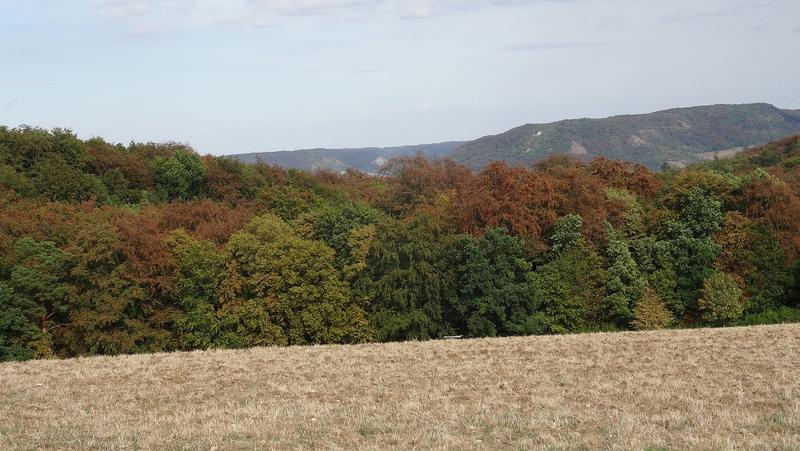

Heat and drought stress on deciduous forest in 2016 in Thuringia, Germany.
MPI-BGC, photo by Susann Héjja
As the number of hot droughts increases worldwide, scientists try to solve the difficulty of making consistent predictions about what will happen to plants and vegetation in the future. This is of importance for land-surface models used to predict climate change because plants take up about half of the CO₂ emissions that humans put in the atmosphere.
Therefore, the effect of sudden shifts in plant populations at large scales, such as tree die-off observed globally in recent decades, could affect the rate at which the climate changes. Current global vegetation models have a hard time producing consistent estimates of plant CO₂ uptake, and their predictions vary widely based on the assumptions they use about how plants respond to environmental stress.
“Droughts are simultaneously happening over large regions of the globe, affecting forests with very different trees,” says Liz Blood, director of NSF’s Macrosystems Biology program. “The discovery of how droughts cause mortality in trees, regardless of the type of tree, allows us to make better regional-scale predictions of droughts’ effects on forests.”
Trees and forests are particularly important in this process because they take up and store a lot of carbon, and they also affect their environment in other ways. One idea for improving these models is to base forest responses on how trees die in response to heat, drought, and other climate stresses. But progress on this has been limited by disagreement over whether carbon starvation or hydraulic failure, the inability of a plant to move water from roots to leaves, is the true cause of death in trees.
Plants transpire large amounts of water for transporting nutrients and for cooling but also to carry out photosynthesis. Transpiration is facilitated by stomata, small pores in the leaves that also let in CO₂. Trees respond to the stress of drought by closing those pores and hence reduce both water loss and photosynthesis. At that point, they need to rely on their stored sugars and starches to stay alive, and could die from carbon starvation if they run out before the drought is over.
Also as the soil dries out, trees have to suck harder to get water out of the soil, thereby increasing the risk of gas bubbles forming in their vessels. The bubbles, or embolisms, interrupt the transport of water from the roots upwards to the leaves, a process we call hydraulic failure and which may become lethal as the whole tree dries out.
A new study published in Nature Ecology and Evolution, led by Henry Adams at Oklahoma State University, brought together 62 scientists from across the globe to synthesize all known research from drought manipulation studies that killed trees. They found that hydraulic failure was universal when trees died, whereas carbon starvation was a contributing factor roughly half of the time.
“This study makes a substantial scientific contribution because it combines results from many different experiments in a consistent way. We can now draw general conclusions that we couldn’t make from the individual case studies” states Henrik Hartmann, scientist at the Max Planck Institute for Biogeochemistry in Jena, who conducted two of the drought stress experiments included in the meta-analysis and is one of the main authors.
The new study documents that both carbon starvation and hydraulic failure appeared to occur as trees died. “This makes sense, because stored sugars and starches are also im-portant for preventing hydraulic failure by acting as “osmoprotectants,” increasing the tree’s ability to hold on to its water. ” says Henrik Hartmann. The study’s results help link together the theories of carbon starvation and hydraulic failure, and provide a strong suggestion for how to go about improving vegetation models and overall predictions of climate change.
The interdisciplinary approach served the purpose of the NSF’s “macrosystems biology” grant program. Funding from this project supports, “predictive understanding of large-scale biological responses to climate [and] land-use change.” By forging a unified theory of the most basic question – what actually kills a tree in a drought? – scientists may now focus on effective solutions.
“These findings zing in to help us improve our understanding of how trees die, which is critical to understand in the context of climate change,” says collaborator David Breshears, professor of natural resources at the University of Arizona.
Original publication
Adams et al. (61 co-authors). A multi-species synthesis of physiological mechanisms in drought-induced mortality. Nature Ecology and Evolution, DOI: 10.1038/s41559-017-0248-x
Contact at Max Planck Institute for Biogeochemistry
Dr. Henrik Hartmann
hhart@bgc-jena.mpg.de
Phone: +49.3641.576294
Mobile: +49.171.8188273
Contact at Oklahoma State University
Henry Adams, PhD
Assistant Professor – Environmental Ecology Lab
Department of Plant Biology, Ecology, & Evolution
henry.adams@okstate.edu
Mobile: +1 303 819 6715












